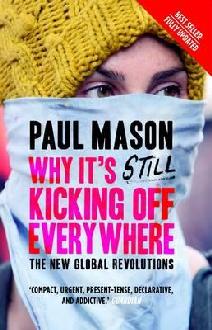Over 30 years of anarchist writing from Ireland listed under hundreds of topics
Review of Paul Mason, 2013, Why It’s STILL Kicking Off Everywhere
 A question. If depression is the inability to construct a future, does depression not appear very like the world’s prevailing mood or zeitgeist right now? As I write, the immense working majority faces into continued hierarchy, exploitation and polarisation, characterised by, among other things, ecological catastrophe, austerity without end, technocratic governance, nuclear annihilation, escalation of war... Compounding these dilemmas is our collective inability, real or illusory (I am not sure which), to construct an alternative future.
A question. If depression is the inability to construct a future, does depression not appear very like the world’s prevailing mood or zeitgeist right now? As I write, the immense working majority faces into continued hierarchy, exploitation and polarisation, characterised by, among other things, ecological catastrophe, austerity without end, technocratic governance, nuclear annihilation, escalation of war... Compounding these dilemmas is our collective inability, real or illusory (I am not sure which), to construct an alternative future.
Today, it is easier to imagine the end of the world than the end of capitalism. And yet. Something else is stirring. 2011 occasioned a shared, transnational impulse of ‘outrage’, ‘indignation’ and ‘enough’ against the cruelties of global financial institutions and the petty thuggery of enthralled states. The occupation of the world’s squares was simultaneously an impulse of ‘hope’, ‘solidarity’ and ‘the commons’, directed towards a dimly perceived yet somehow more just, more humane future. Tracking their emergence, evolution, fading, and re-emergence around the world – now in Cairo, then in Syntagma, here in Zuccotti Park, there in Puerta del Sol - Paul Mason, BBC journalist and author, has provided an insightful record and (somewhat more questionable) analysis of these revolts.
Last year’s Why It’s Kicking Off Everywhere (2012) documented the evolving wave of revolt and revolution from the Arab Spring to riots in Athens and Manila, from the student occupations in the UK to the emergence of the indignados in Spain and Occupy in the US. (Andrew reviewed it for WSM) The updated edition, Why It’s STILL Kicking Off Everywhere (2013) expands on the flowering and repression of revolt in Russia, updates the analysis of Greece and Spain and revisits Mason's thesis of the ‘networked’ revolution. The book is a terrific read, largely because Mason – while never losing sight of historical, economic or political context - foregrounds the voices and actions of the discontented and the dispossessed. And, of course, as even Financial Times journalists will safely admit, much of what the protestors have to say is worth listening to. This direct reporting is a real strength: ‘Instead of Guy Debord [theorist du jour of London’s art college graduate], the under-eighteens opted for Anglo-Saxon literalism. They swarmed into Trafalgar Square, off buses from London’s poorest neighbourhoods, clambered over the lion statues and chanted: “David Cameron, fuck off back to Eton!”’.
Mason’s analysis of why the global uprisings are taking place is also valuable, not so much for pointing out the ongoing role of a pronounced crisis of capitalism as for detailing the particular features that make the revolts somewhat unique or special this time around. These particularities include the intra-elite mechanics of austerity policies and currency manipulation, the role of speculation in raising food prices (central to the Arab Spring) and, common to all risings, the potent force presented by ‘the graduate without a future’. But Mason is probably best known for emphasising the role of ‘networked individuals’ in the revolts, the increasing numbers of us who use communications technology such as Facebook and Twitter to socialise and, as occasions arise, to organise. (The stats are remarkable: Facebook’s user base rose from 100 million in 2008 to 750 million in 2012; Twitter users sent 1 billion tweets between 2006 and 2008; in 2012, 250 million users now send as many every week). Techno-fora users, characterised as people with ‘weak ties, multiple loyalties and greater autonomy’, create horizontal social networks capable of challenging repressive states on the one hand and closed ideas or dogmas (rightist or leftist) on the other.
The book’s first weak point relates to its understanding of ‘everywhere’. The focus is on Europe, the US and the Arab Spring. Manila is also analysed to include a section on slum-dwelling (increasingly important politically in a rapidly urbanising world). But new student movements in Canada and Chile are not considered. Neither are the networked rioters in London in 2011. China is barely mentioned, notwithstanding its tentative ‘jasmine revolution’ or increasing waves of ‘mass incidents’ arising from peasant, worker, urban and ethnic struggles throughout the 2000s and 2010s. These include strikes at the Foxconn Zhengzhou factory plant where the hardware for social networking (such as the iPhone) is being produced. The most glaring omission though is South America, particularly the Zapatistas in Mexico or post-financial crisis movements in Argentina. The horizontal practices that evolved here in the 1990s and 2000s are a vital reference point for contemporary waves of resistance.
This brings us to the book’s second major weak point: it’s analysis of ‘why’ it’s kicking off. To an extent, Mason has hit upon the uptake of social media, emphasised its use as the new factor and, in doing so, just confirms what he initially expected to find. Alternative emphases exist. What if the emergence of horizontal forms of revolt is not the product of communicative/technological change but is actually the last-ditch option for civil society once the state has been captured, directly and visibly, by international governance networks (such as the IMF) and the private interests they serve? What is left for those who want a more equal, more democratic society but to start assembling in squares, to institute direct democracy? This seems to me to be an important part of the story in Chiapas, Argentina and everywhere the IMF has ‘come to town’, one that the book omits.
In summing up, Mason draws an uncontroversial conclusion that the economic crisis is here to stay (for the next five years at least) and so too is the politics of contesting austerity. Starkly, this means that the possibility of something ‘viscerally fearful’, such as a fascist breakthrough in Greece or Northern Europe, remains. Meanwhile, the social movements of 2011, having been ousted from the world’s public squares in 2012, are now faced with a logjam-inducing relationship to existing political institutions. In the short to medium term, Mason suggests, their questioning of methods and aims will probably occur alongside a move into ‘cooperative economic practices’ such as took place with Occupy Sandy in New York or the local solidarity economies in Spain and Greece. Certainly, it would be wrong to dismiss the powers and interests arrayed against these movements. But in 2011, unprecedented in its scale, pace and development, the genie of transnational solidarity escaped from the bottle. As the conditions for provoking revolt remain, so too does the potential for that solidarity to evolve into something more potent – a future worth constructing.
WORDS: Tom Murray
This article is from
Workers Solidarity 129, April May 2013


